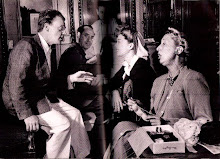 I just recent watched the 1936 James Cagney movie Great Guy, and it was okay but the film quality was poor and grainy and so was the sound. James Cagney was good as Johnny Cave, a deputy in the New York Department of Weights and Measures who chases crooks and cheats. It is, to say the least, a comedown from the FBI. There is a difference in one's level of involvement when one is watching public enemies being run to the ground, and when one is watching petty crooks, like butchers who put their thumb on the scale or gas station attendants who give short measure to their customers, being brought to justice. Cagney's character is congealed by the desire to not resort to violence or even a wisecrack in fulfilling his duty for the public's well-being.
I just recent watched the 1936 James Cagney movie Great Guy, and it was okay but the film quality was poor and grainy and so was the sound. James Cagney was good as Johnny Cave, a deputy in the New York Department of Weights and Measures who chases crooks and cheats. It is, to say the least, a comedown from the FBI. There is a difference in one's level of involvement when one is watching public enemies being run to the ground, and when one is watching petty crooks, like butchers who put their thumb on the scale or gas station attendants who give short measure to their customers, being brought to justice. Cagney's character is congealed by the desire to not resort to violence or even a wisecrack in fulfilling his duty for the public's well-being. Mae Clarke, who was his leading lady in The Public Enemy (1931) and Lady Killer (1933), is back as his girlfriend in this film and even though I'm jealous of any Cagney romance, I'm not jealous of this one. Rather I'm relieved for her, as she does not get pushed around or bullied by Jimmy Cag
Mae Clarke, who was his leading lady in The Public Enemy (1931) and Lady Killer (1933), is back as his girlfriend in this film and even though I'm jealous of any Cagney romance, I'm not jealous of this one. Rather I'm relieved for her, as she does not get pushed around or bullied by Jimmy Cag ney. After getting smashed in the face by a grapefruit and being dragged across the room by the hair by Cagney, Clarke finally gets to bully him so it's sort of revenge on her part! She is the straight-laced girlfriend who insists that they eat in a cafeteria less fancier t
ney. After getting smashed in the face by a grapefruit and being dragged across the room by the hair by Cagney, Clarke finally gets to bully him so it's sort of revenge on her part! She is the straight-laced girlfriend who insists that they eat in a cafeteria less fancier t han the Ritz so they can save money for their stash (and during the Depression, it was very wise to do so). This, like most of their other scenes, amounts to premarital nagging, and one gets the impression that if any grapefruit is going to be thrown in this relationship, she will be the one doing the throwing. I especially like the scenes where they kiss and talk on a sofa that looks like it's in their home but is actually in a furniture store!! That is so like The Simpsons and Family Guy, where it seems like they're doing one but they're actually doing another.
han the Ritz so they can save money for their stash (and during the Depression, it was very wise to do so). This, like most of their other scenes, amounts to premarital nagging, and one gets the impression that if any grapefruit is going to be thrown in this relationship, she will be the one doing the throwing. I especially like the scenes where they kiss and talk on a sofa that looks like it's in their home but is actually in a furniture store!! That is so like The Simpsons and Family Guy, where it seems like they're doing one but they're actually doing another.As for the supporting cast, they are adequate, but they are generally overshadowed rather easily by Cag ney. Mae Clarke is relatively appealing as Cagney's fiancée, but she mostly has to react to situations, since the script and dialogue don't give her much more to work with. The movie as a whole largely follows a familiar pattern, and with a lesser star it would have been a rather routine affair. Cagney brings it up a couple of notches, and his own performance certainly won't disappoint anyone either. And of course, the Cagney acting style is unchanged. All the gestures are in place, but particularly the floating, air-sculpting hands, this time not overdone. In later years the use of his hands as dramatic punctuation dimishing considerably, but in this yet early phase of his career they are deftly and fascinatingly employed. (But I swear to God, they annoy me in general. I heard that he uses them all the time in Hard to Handle.) He seems to b
ney. Mae Clarke is relatively appealing as Cagney's fiancée, but she mostly has to react to situations, since the script and dialogue don't give her much more to work with. The movie as a whole largely follows a familiar pattern, and with a lesser star it would have been a rather routine affair. Cagney brings it up a couple of notches, and his own performance certainly won't disappoint anyone either. And of course, the Cagney acting style is unchanged. All the gestures are in place, but particularly the floating, air-sculpting hands, this time not overdone. In later years the use of his hands as dramatic punctuation dimishing considerably, but in this yet early phase of his career they are deftly and fascinatingly employed. (But I swear to God, they annoy me in general. I heard that he uses them all the time in Hard to Handle.) He seems to b e at ease and enjoying himself tremendously--the performance turned in here is intelligent and crackles with his unique energy and surefire charisma. Mae Clarke's presence lends a definite Warner's feel to the overall production, and the story moves along smartly after a rocky introduction that seems to begin three or four reels into the story.
e at ease and enjoying himself tremendously--the performance turned in here is intelligent and crackles with his unique energy and surefire charisma. Mae Clarke's presence lends a definite Warner's feel to the overall production, and the story moves along smartly after a rocky introduction that seems to begin three or four reels into the story.
 ney. Mae Clarke is relatively appealing as Cagney's fiancée, but she mostly has to react to situations, since the script and dialogue don't give her much more to work with. The movie as a whole largely follows a familiar pattern, and with a lesser star it would have been a rather routine affair. Cagney brings it up a couple of notches, and his own performance certainly won't disappoint anyone either. And of course, the Cagney acting style is unchanged. All the gestures are in place, but particularly the floating, air-sculpting hands, this time not overdone. In later years the use of his hands as dramatic punctuation dimishing considerably, but in this yet early phase of his career they are deftly and fascinatingly employed. (But I swear to God, they annoy me in general. I heard that he uses them all the time in Hard to Handle.) He seems to b
ney. Mae Clarke is relatively appealing as Cagney's fiancée, but she mostly has to react to situations, since the script and dialogue don't give her much more to work with. The movie as a whole largely follows a familiar pattern, and with a lesser star it would have been a rather routine affair. Cagney brings it up a couple of notches, and his own performance certainly won't disappoint anyone either. And of course, the Cagney acting style is unchanged. All the gestures are in place, but particularly the floating, air-sculpting hands, this time not overdone. In later years the use of his hands as dramatic punctuation dimishing considerably, but in this yet early phase of his career they are deftly and fascinatingly employed. (But I swear to God, they annoy me in general. I heard that he uses them all the time in Hard to Handle.) He seems to b e at ease and enjoying himself tremendously--the performance turned in here is intelligent and crackles with his unique energy and surefire charisma. Mae Clarke's presence lends a definite Warner's feel to the overall production, and the story moves along smartly after a rocky introduction that seems to begin three or four reels into the story.
e at ease and enjoying himself tremendously--the performance turned in here is intelligent and crackles with his unique energy and surefire charisma. Mae Clarke's presence lends a definite Warner's feel to the overall production, and the story moves along smartly after a rocky introduction that seems to begin three or four reels into the story. James Cagney made this movie after winning a contractal battle with Warner Brothers. According to the book "The Complete Films of James Cagney" by Homer Dickens (or Simpson?):
When Great Guy was released in, in December 1936, Cagney had been off the screen
for one year. During this time he and Warner Bros. battled in court, with Jimmy
finally becoming victorious. This was his first picture (in a two-picture-a-year
deal) with the independent outfit Grand National, and was based on the "Johnny
Cave Stories" by James Edward Grant that had been appearing in the Sunday
Evening Post. John G. Blystone neatly directed on a shoestring budget, which was
all too apparent, since a Warners picture had definite production values that
were missing here. But, despite the budget, Great Guy, or Pluck of the Irish as
it was called in England, was a nifty an exciting melodrama. It was fun seeing
Mae Clarke back in a Cagney picture.
I didn't really watch the fighting scenes because they were too dramatic. I would recommend this film for any James Cagney fan who likes watching him in melodramas. Happy commenting!!! 
(Next blog: The Fight ing 69th [1940])
ing 69th [1940])

(Next blog: The Fight
 ing 69th [1940])
ing 69th [1940])














No comments:
Post a Comment